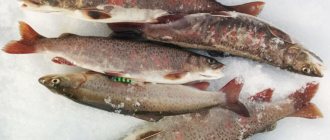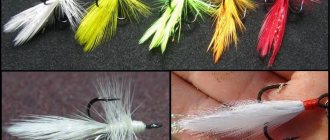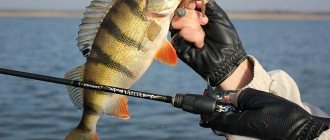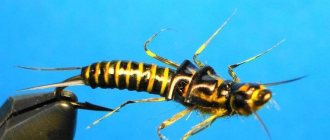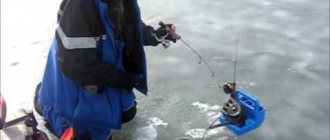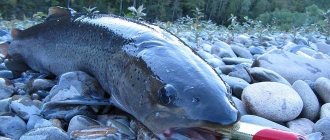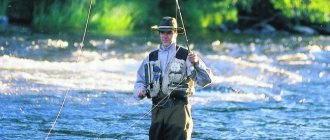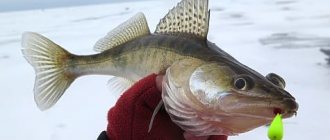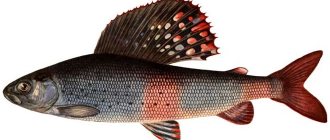Lenka habitats
Lenok is a fish that loves cold, fast-flowing waters, and is therefore widespread throughout Siberia.
A large number of individuals are found in the area from the Ob basin to the rivers flowing into the Sea of Japan and Okhotsk. They are also found in the Mongolian and Chinese seas with fast and cold currents: Selenga, Nujiang, Yellow River.
In summer, fish are common in taiga rivers with a deep and uneven bottom filled with cold springs. Favorite places in rivers near Lenka are parking lots near the edges, cracks in the bottom, sunken logs and places where cold streams of water converge. The fish prefers to move along a weak current, and after strengthening and becoming established, it moves to the riffles for prey.
Let's celebrate! To feed in the autumn-winter, the lenok moves to large rivers and lakes, where it finds depressions in the bottom and remains there for the winter. During wintering, it can move in small schools and stay close to the shore.
Features of catching predators by season
In winter, flax continues to actively feed, and therefore it is much easier to catch it than in any other season.
In the spring-autumn period, the fish begin to rise from the bottom, so the bite is observed throughout the reservoir. During such periods, it is better to use dead fish, worms or insects for bait and fish with a spinning rod. Fish after spring adaptation does not require heavy spinners and specialized fishing rods, rather lightweight gear;
In the summer, fly fishing is used with gear made from insects or rodents. During the warm period, the fish react to trout-shaped spoons and sinking flies. The spoon should be selected two sizes larger than for trout. Hunting for fish is carried out along the bottom, and in the evening and at night - on the surface;
Note! In winter, a spinning rod, a short fishing rod, a spinner, specialized reels and a fishing line of 0.25 are used. During this period, the fish are inactive, but retain the habits of a predator, so the lenok pulls the bait to the bottom, where it tries to pick it. The fisherman should be patient and have enough fishing line (the fish moves at least 20 meters).
Catching grayling with a spoon
Spinner bait for grayling finds its wide application when the predator retreats to the depths, which happens with the onset of cold weather, approximately from the second half of September. Therefore, in terms of the season of the year, autumn is the most preferable time for choosing a grayling spoon as the main fishing tool. Next, we will look at the technical and strategic aspects of grayling spinning fishing using oscillating and rotating spinners.
Fishing tactics
In the fall, graylings descend to the lower reaches of rivers and streams, closer to the mouths at the confluence with lakes, where the current becomes slower and the depths of the fish’s mooring areas increase significantly in size. The search for fish is carried out at the boundaries of the junction of fast and slow water, fishing the middle and bottom horizons. Predators can go to the shallows adjacent to the mouths with faster water only on relatively warm days with sunny weather.
Important! When fishing promising places, make 5-7 casts, changing baits and in the absence of bites, move to other points, without particularly stopping at places without bites.
They return to the old points no earlier than two hours, again working according to the fishing algorithm described above. If there are bites, you can count on catching a couple or two individuals that stay closely together, in a small flock, near the found prey spot.
Casting and wiring rules
When making casts and retrieving, they are guided by the speed of the current and the structure of the reservoir. As you know, graylings are ambush hunters and they do not pursue their prey, but calmly wait for them to approach a distance at which they can reach the food object without much energy expenditure. Therefore, a very important point is to present the bait under the nose of the predator, which can be done by using some casting and retrieving methods.
If fishing is carried out at the mouth of a river, the spoon is thrown into the area where the river flows into the lake. Pulling the spinner against the current diagonally to the shore, they try to choose the trajectory of the wire in the place where two different-speed water flows touch.
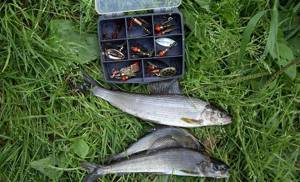
When fishing from a boat, casts are made to the coastlines, fishing the entire adjacent water area. Retrieving from the shore is carried out on slow reels, performing pauses and small pauses, thus checking for the presence of trophies in areas where the predator may be staying.
When fishing rivers and streams, baits are thrown upstream, floated in a controlled manner at an angle of 40–50 degrees, preventing them from becoming too deep. The spoon should not touch the bottom, but should move naturally in the water flow, without abruptness or a radical change of direction.
Fishing technique
The technique of grayling fishing is based on three main fishing techniques, having mastered which the angler will be able to ensure successful spinning hunting. The first technique is based on the implementation of leisurely wiring against the current. The spinner is advanced at low speed, periodically making short stops, at which bites most often occur.
Diagonal fishing is considered a classic for grayling fishing. In this technique, the wiring should be at an angle to the flow. With this type of feeding, pauses are made longer than usual, allowing the bait to reach a flat trajectory under the influence of current forces. When the spinner is demolished, a predator attack occurs.
The third feeding option is practiced when light spinners are used, which are carried along the current. The spoon is launched into the area of possible anchorage points for the predator, allowing its play to be carried out by the forces of the current. The rod is used to occasionally hold and adjust the trajectory of movement. The fish reacts to the bait naturally swimming by, in most cases attacking it, followed by self-hooking.
Choosing gear for catching lenok
On Lenka, fishermen use two types of gear: spinning and bottom fishing rod:
- Spinning. The only requirement is lightness, flexibility and in some cases a spinning reel with a friction brake. You can take a monofilament line with a length of 0.2 - 0.25, which is not noticeable in the water;
- An ordinary fishing rod. A budget option that is familiar to many. A fisherman can make a fishing rod himself, the main thing is that the length does not exceed 2.5 meters. An inertial coil (“Neva”) can be attached to the bottom one. When fishing, they use several ordinary hooks; while one is just taking a bite, the other is already hooking the fish.
Let's celebrate! Lenok is good for spinning in the autumn-winter, and the “throwaway” will be a good option for the spring-summer period, when you can fish while standing in the water.
Rod
The rod should help the fisherman “remove” the fish and hook it at the right moment, so medium rods with a length of 2.5-2.7 m with a load of up to 30 g are suitable.
These rods have high shock absorption, which allows you to reduce the amount of force expended on avoiding obstacles and stones. The line and reel do not fail, and the rod does not bend.
Note! If a fisherman decides to catch lenok from a boat or while standing in the water, then you can choose a rod 2.1 - 2.4 meters long with a lightweight inertial reel.
Coil
To catch lenok, spinners will need a spinning reel (2000-3000 spool), which is suitable for any bait and does not require special selection of a fishing rod. The friction brake will reduce the activity of the predator and will not tear the fishing line.
When choosing, you need to pay attention to the weight, gaps and proper placement of the fishing line in the reel. All criteria must work optimally so that the flax does not slip off at the last moment. Experienced fishermen note Japanese models, which have no more than 4 screws.
Fishing line, cord
The line must withstand a load of up to 10 kg, so monofilament or breaking lines with a thickness of up to 0.6 mm are suitable for the line.
On a rocky, gravelly day, fishing line will be ineffective because the reel may break off or the thread may be damaged when lifting the catch. In reservoirs with a complex, uneven bottom, a fishing line with a range of up to 30 m and a diameter of 0.6 will work.
Hunting for lenok on Lake Baikal
The predator is mainly caught in tributaries, although the species is also common in the lake itself. According to experienced fishermen, in Baikal there are trophy specimens reaching seven and even 8 kilograms in weight. You can only determine the veracity of rumors through your own experience. You should immediately forget about coastal fishing; to move around the water area you will need a boat equipped with a motor.
To learn more:
Taimen: a valuable fish of the salmon family
I would like to note that targeted fishing for lenka is prohibited, so it makes sense to engage in sport fishing, according to the “catch and release” principle. The presence of several individuals in the grayling by-catch allows you to take them with you.
What to use to catch Baikal lenok
All permitted weapons are used. Trophy specimens prefer large bait, so there’s no need to waste time on trifles. Regularly changing the fishing point should be accompanied by a change in the angler’s tactics. Only by picking up the “key” should you count on a worthy trophy. You can experiment with vertical spinners. An onboard fishing rod will come in handy.
Hunting for salmon is a very interesting activity, covering a huge area of water, starting from Transbaikalia, Yenisei and reaching Mongolia. Having visited such a place once, you want to return to it again.
What to catch lenka with: bait
https://youtu.be/0T5PnPPHDVM
The type of bait depends on the area, so you should prepare your luggage in advance.
On a shallow and transparent bottom with a fast current, large baits that resemble the movement of a small fish will be effective. They range in size from 45 to 55 mm and have a #8 tee with an orange tail.
For example: “Pig”, “Kola”;
- For boat fishing up to 40 mm with tee no. 9 – 10 with orange camouflage;
- On riffles, heavy baits up to 50 mm or trihedrons up to 40 g;
- Calm and deep water is ideal for models with a rotating mechanism No. 8-10 up to 40 mm. For example, “Nevskaya”, “Universal”.
Important! The color of the bait depends on weather conditions and the color of the water in the river. The dark color of the bait means clear water, the bright and shiny color means muddy water and the dark time of day.
Spoons
Lenok loves spoons of large and medium sizes, small ones similar to fish, and takes them during the winter hungry period. During spawning and active biting, the lure should be up to 30 mm in size with a large spinning tail so that the fish mistakes the tackle for food.
In the spring-autumn period, a “petal” with a black outer part and a silver inner part is also suitable. In autumn, it is better to take plain, flat mechanisms with dots. A win-win option would be a black lure with bright red spots; fish willingly go for such bait.
Jigs
For jig fishing, you will need a thin line from 0.2 to 0.22. The jig itself (models No. 6, 7) must have a thick fore-end so that large fish cannot break the line and bend the hook.
Models are suitable for lenka up to 3 kilograms in size:
- For hunting lenok in winter, a jig is suitable in the shape of a “drop” with an elongated end, made of copper or brass. Large individuals bite with a shifted center of gravity forward, and small ones evenly balanced jigs;
- In the remaining seasons of the year, the lenok prefers jigs with bright colors that resemble fry. The weight of the bait on such a jig should not exceed 7 grams.
Good to know! Jigs that resemble the shape of an insect or worm are in great “demand” among fish.
Tactics and fishing techniques
The bite is often a way out. After capturing several individuals, the flock may scatter. Regardless of fishing methods, it is worth being active in fishing and not staying in one place for too long. Fishing with an artificial mouse is carried out during the period of “liquid” water. In addition to the effectiveness, the fishing turns out to be spectacular, because bites occur near the surface. Imitations of rodents, both branded and homemade, are used as bait.
Catching lenok with a “mouse” is as effective as with a spinner. To do this, the bait is thrown a little upstream from the promising point, under the opposite bank. The wiring should be uniform, exactly simulating a rodent swimming across a river. If the fish does not show interest, it makes sense to change the bait to another model, smaller or in a different color.
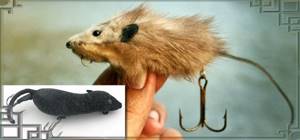
How to make a mouse
The greatest number of bites occurs in the evening. This is due to the activity of rodents at night. You can try this method at nightfall and at dawn. The mouse is made with your own hands from a dense black material. A metal wire is threaded through the body, having ears on both sides. A tee is mounted on the back, and the front ring serves as a hook for the carbine. The compound mouse is in demand among predators. The mobility of the body attracts the lenok and provokes it to attack.
To learn more:
Char: description of red fish
Bottom tackle
In Transbaikalia and other regions of Siberia, the running donka is popular. Structurally, it consists of several elements:
- main line, 0.3 mm in diameter;
- a sinker that will hold the equipment at the bottom;
- one or two leashes.
Fry, insects and worms are used as bait. The tackle is waded on the stream or carefully cast from the shore. The “Zakidushka” can be used both in fast and moderate currents, by adjusting only the weight of the sinker used.
The advantage of the rig is the detection of feeding fish at relatively large depths. There are times when a school cannot be detected on the surface of the water, and it is in such situations that the donka comes to the rescue.
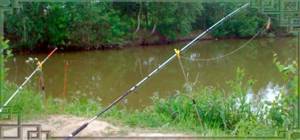
Downhill fishing method
Not so common among lenok hunters. Its huge disadvantage is the constant loss of bait, because fishing is carried out along the bottom of the river, where the tackle catches snags and large stones. The design's appearance resembles a donkey and differs only in the use of a smaller sinker and one leash. The gear is thrown upstream. A light sinker is carried away by an abundant flow, rolling along the bottom, which gives it its characteristic name. You should watch the line tension carefully and at the slightest stop, immediately hook. The bait used is the same as for donkey, but the bites are more careful.
Spinning tackle
When talking about this method, we mean a large number of baits and subcategories of this fishing method. Gear for catching lenok is used in the medium class with an upper test limit of up to 30-35 g. The reel is used of the inertial type.
Budget models do a poor job of laying out the cord, which will result in “beards.” There is no need to skimp on this part. Braided cord has long replaced its monofilament counterpart. The fishing line is used only by old-school local fishermen.
The box must contain all popular types of bait. Wobblers for lenka are also used for grayling, since these species have similar tastes. Despite the transparency of mountain rivers, the fish in them prefer bright colors. Red and green are excellent at tempting predators to bite. Lenka spinners can be painted or have a sticker on the body, are made by hand and, just like wobblers, can be used for grayling.
To learn more:
Characteristics of the Soyka-3 bite alarm
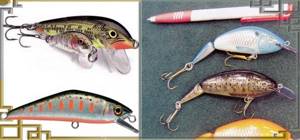
It is better to fish with a spinning rod while standing in the water, since the banks of taiga rivers are covered with dense vegetation, which interferes with free movement. A good bite begins at the end of August, and the peak of activity occurs in September - October. The choice of bait depends on the season, weather and fishing conditions. In a steady flow, a jig is used instead of the usual wobbler or spoon. Spinning gear for lenka is vaguely reminiscent of trout fishing - similar baits, retrieves and fishing tactics.
Methods of catching lenka
Lenok is best suited for several types of fishing:
- Fly fishing;
- Float rod;
- On a bottom fishing rod;
- "Ship";
- Spinning method.
Spinning fishing
Most often, the lenok swims to feed in the rifts, where a spinning angler can hit a good fishing jackpot. For spinning, you need to choose places under trees or an uneven bottom where fish can lie, waiting for their prey. The spinning rod should not exceed 150 cm with a fishing line of up to 0.2 mm.
Fly fishing
Fishing for dark streamers with frequent use of mouse tackle. Common techniques are drifting and stripping, which depend on the type and flow of the river.
Fishing with a float rod
The criteria are the same as for a bottom fishing rod. The main difference is the signaling device on the rod, which begins to move during the bite. This option guarantees that the fisherman will see the catch on time, and the fish will not slip off the hook.
Donk fishing
Hooks No. 7 - 9 with fishing line up to 0.8, if the cast is from the shore, then the fishing line must be at least 20 meters to achieve results. In fast-flowing rivers, you can use a stand. When biting, the fisherman uses smooth hand movements to catch the fish by the fishing line.
Fishing on a boat
Live insects and small fish are used for tackle. The float will be a homemade boat made of wood and foam. The mechanism distracts the fish, and it goes hunting without noticing the hook.
Reviews from fishermen
In winter, perch is often caught on vertical lures, but yesterday I pulled out a young lenka 1,300. I advise you to use a spinning rod, it is convenient for hooking and retrieving. Grade:
Bogdan
I recently bought a Shimano reel for my spinning rod. The fishing line is thin and I was afraid that the catch would be lost, but the Japanese line did not disappoint. Yesterday the bite was good, it broke once, but then I got two lenks! Grade:
Taras
I tried both the boat and the float rod - I didn’t like it. I believe that fly fishing from a spinning rod is used more for lenka. The fish does not slip and bites well. Grade:
Valery
I often bought bright lures with red tails, but recently I decided to buy a plain black one with red specks and the result immediately became noticeable. Lenok in winter goes better with red, yellow, etc. colors. Do not take. Grade:
Nikolai
I constantly catch lenka using burdock moths and don’t want to change my preferences. In my opinion, fish like insects more and go for them much better. Grade:
Sergey
Last winter I pulled out 2 kg of lenka without much preparation. I took an ordinary petal spinner and an inertial reel. The catch from the shore is wonderful. Grade:
Peter
Good to know! Many fishermen prepare for winter fishing on Siberian and Far Eastern rivers a year in advance. The fish is rare and cunning, so the fishing process is fascinating and forces you to show ingenuity. The main thing in a successful catch is clearly thought out details and a little patience.


